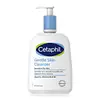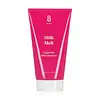What's inside
What's inside
 Key Ingredients
Key Ingredients

 Benefits
Benefits

 Concerns
Concerns

 Ingredients Side-by-side
Ingredients Side-by-side

Water
Skin ConditioningCaprylic/Capric Triglyceride
MaskingGlycerin
HumectantSodium Laurylglucosides Hydroxypropylsulfonate
CleansingColloidal Oatmeal
AbsorbentMaltooligosyl Glucoside
Skin ConditioningSodium Cocoamphoacetate
CleansingHydrogenated Starch Hydrolysate
HumectantAvena Sativa Kernel Oil
Skin ConditioningLauryl Glucoside
CleansingXanthan Gum
EmulsifyingPropanediol
SolventSodium Cocoyl Glutamate
CleansingSodium Lauryl Glucose Carboxylate
CleansingBenzyl Alcohol
PerfumingLactic Acid
BufferingSodium Chloride
MaskingSodium Cocoyl Hydrolyzed Oat Protein
Skin ConditioningCaprylic Acid
CleansingXylitol
HumectantTetrasodium Glutamate Diacetate
Tocopherol
AntioxidantCocos Nucifera Fruit Extract
EmollientLeuconostoc/Radish Root Ferment Filtrate
AntimicrobialLactobacillus Ferment
Skin ConditioningAgastache Mexicana Flower/Leaf/Stem Extract
Skin ConditioningButylene Glycol
HumectantWater, Caprylic/Capric Triglyceride, Glycerin, Sodium Laurylglucosides Hydroxypropylsulfonate, Colloidal Oatmeal, Maltooligosyl Glucoside, Sodium Cocoamphoacetate, Hydrogenated Starch Hydrolysate, Avena Sativa Kernel Oil, Lauryl Glucoside, Xanthan Gum, Propanediol, Sodium Cocoyl Glutamate, Sodium Lauryl Glucose Carboxylate, Benzyl Alcohol, Lactic Acid, Sodium Chloride, Sodium Cocoyl Hydrolyzed Oat Protein, Caprylic Acid, Xylitol, Tetrasodium Glutamate Diacetate, Tocopherol, Cocos Nucifera Fruit Extract, Leuconostoc/Radish Root Ferment Filtrate, Lactobacillus Ferment, Agastache Mexicana Flower/Leaf/Stem Extract, Butylene Glycol
 Reviews
Reviews

Ingredients Explained
These ingredients are found in both products.
Ingredients higher up in an ingredient list are typically present in a larger amount.
Glycerin is already naturally found in your skin. It helps moisturize and protect your skin.
A study from 2016 found glycerin to be more effective as a humectant than AHAs and hyaluronic acid.
As a humectant, it helps the skin stay hydrated by pulling moisture to your skin. The low molecular weight of glycerin allows it to pull moisture into the deeper layers of your skin.
Hydrated skin improves your skin barrier; Your skin barrier helps protect against irritants and bacteria.
Glycerin has also been found to have antimicrobial and antiviral properties. Due to these properties, glycerin is often used in wound and burn treatments.
In cosmetics, glycerin is usually derived from plants such as soybean or palm. However, it can also be sourced from animals, such as tallow or animal fat.
This ingredient is organic, colorless, odorless, and non-toxic.
Glycerin is the name for this ingredient in American English. British English uses Glycerol/Glycerine.
Learn more about GlycerinWater. It's the most common cosmetic ingredient of all. You'll usually see it at the top of ingredient lists, meaning that it makes up the largest part of the product.
So why is it so popular? Water most often acts as a solvent - this means that it helps dissolve other ingredients into the formulation.
You'll also recognize water as that liquid we all need to stay alive. If you see this, drink a glass of water. Stay hydrated!
Learn more about WaterXanthan gum is used as a stabilizer and thickener within cosmetic products. It helps give products a sticky, thick feeling - preventing them from being too runny.
On the technical side of things, xanthan gum is a polysaccharide - a combination consisting of multiple sugar molecules bonded together.
Xanthan gum is a pretty common and great ingredient. It is a natural, non-toxic, non-irritating ingredient that is also commonly used in food products.
Learn more about Xanthan Gum